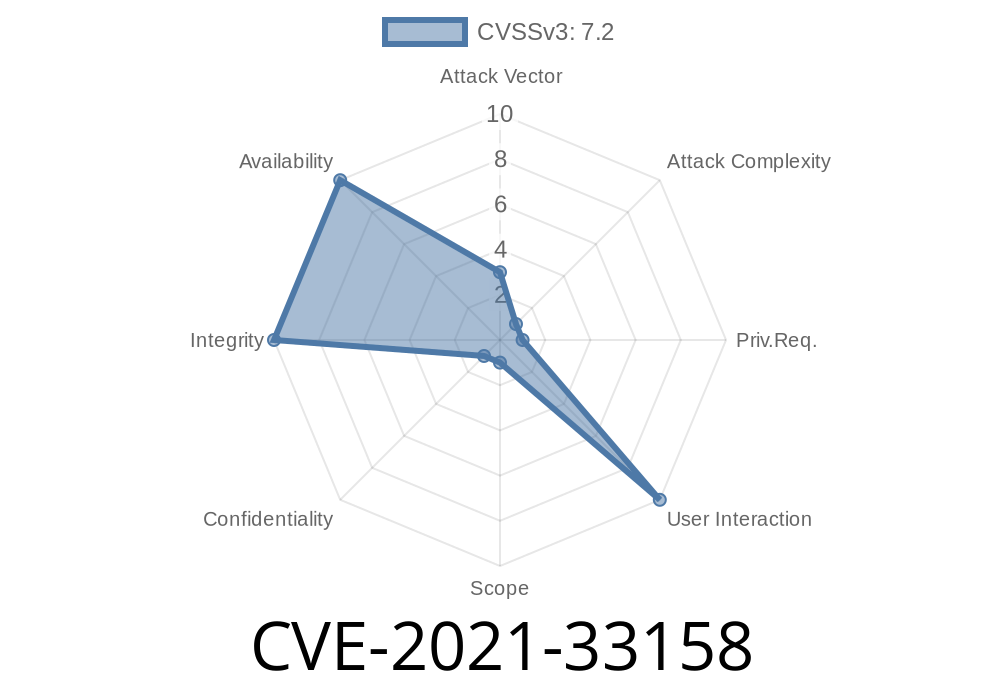If you use Intel network adapters or manage systems relying on Intel’s Ethernet Controller I225, it’s time to pay attention to CVE-2021-33158 — a vulnerability that could let a privileged user climb the privilege ladder, all by taking advantage of a flaw in the firmware.
In this article, I’ll break down what this CVE means, where and how it happens, show how the bug can be triggered, and point you to key resources. You’ll get the facts in plain language, with code snippets to help clarify.
What Is CVE-2021-33158?
Short version:
This is an Improper Input Neutralization bug (think: input sanity checks missing or broken) in the manageability firmware of some Intel(R) Ethernet Adapters and I225 controllers. If someone already has privileged access on the machine, they could potentially use this vulnerability for local privilege escalation — rising to even greater system powers.
Intel’s official advisory is here:
🔗 INTEL-SA-00530
Here’s what Intel lists as affected
- Intel® Ethernet Controller I225 family: Some SKUs/versions
- Intel® Ethernet Adapters: Select models using affected Chipsets/Firmware
Only systems where the manageability firmware is enabled and accessible are at risk. This is mostly enterprise, datacenter, and high-end workstation gear, but some desktops may also be impacted if the management/firmware interface is enabled.
How the Vulnerability Works
Official summary:
> “Improper input neutralization in the firmware for some Intel(R) Ethernet Adapters and Intel(R) Ethernet Controller I225 Manageability firmware may allow a privileged user to enable escalation of privilege via local access.”
What does that mean?
The firmware doesn’t clean or check certain types of input the way it should. If a user already on the system (with some privileges, potentially as a lower-level admin or service account) can get access to this component locally, they might craft special input (commands or data) that tricks the firmware into doing something it shouldn’t — like running code at a higher privilege level.
If you’re a system admin, this means someone abusing this hole could gain system or root-level powers, possibly bypassing OS protections.
Proof of Concept (PoC) Scenario
Due to the nature of this CVE — firmware-level manageability in business grade adapters — you won’t find ready-to-run exploits on the Internet. But here’s how a simplified attack flow would work:
1. Attacker gains a privileged foothold (such as an account that can talk to the management controller)
2. Attacker sends crafted input (improperly checked commands/data) to the firmware via special interfaces, such as ioctl calls or out-of-band management tools
3. Firmware mishandles the input, running attacker-chosen code or escalating their privilege to SYSTEM/root or similar
Example Code Snippet
Let’s imagine a utility that interacts with the Intel I225 management interface via a device file on Linux /dev/mei.
The attacker might use this utility to send corrupted data
#include <stdio.h>
#include <fcntl.h>
#include <unistd.h>
#include <sys/ioctl.h>
#include <string.h>
#define FIRMWARE_IOCTL_COMMAND x1234 // Placeholder value
int main() {
int fd = open("/dev/mei", O_RDWR);
if (fd < ) {
perror("Open failed");
return 1;
}
char buffer[256];
memset(buffer, 'A', sizeof(buffer)); // Fills buffer with 'A', may overflow
// Send a malformed command that exploits improper neutralization
if (ioctl(fd, FIRMWARE_IOCTL_COMMAND, buffer) == -1) {
perror("IOCTL failed");
close(fd);
return 1;
}
close(fd);
return ;
}
> Note: The above example is illustrative only. Actual exploit code would depend on the specific logic flaw in the firmware (which is proprietary and not open source).
How Do You Fix It?
Update your firmware!
Intel released firmware fixes for affected adapters and controllers. Check your device vendor’s support page, or see the official Intel advisory for download links.
For Intel’s own advice:
For common adapters:
How Dangerous Is This?
Threat model:
An attacker already needs local, privileged access. This is most dangerous in environments where there are untrusted admins, privileged service accounts, or where malware/botnet operators have a foothold.
What can happen:
Original References
- CVE-2021-33158 at NIST NVD
- Intel’s Security Advisory INTEL-SA-00530
- Intel Downloads and Tools
Bottom Line
CVE-2021-33158 is a potent reminder that even battle-tested hardware like Intel’s network adapters can have firmware flaws enabling privilege escalation. The silver lining: you need to already have some privileged system access to exploit it.
What should you do?
Timeline
Published on: 02/23/2024 21:15:09 UTC
Last modified on: 05/16/2024 21:15:49 UTC
